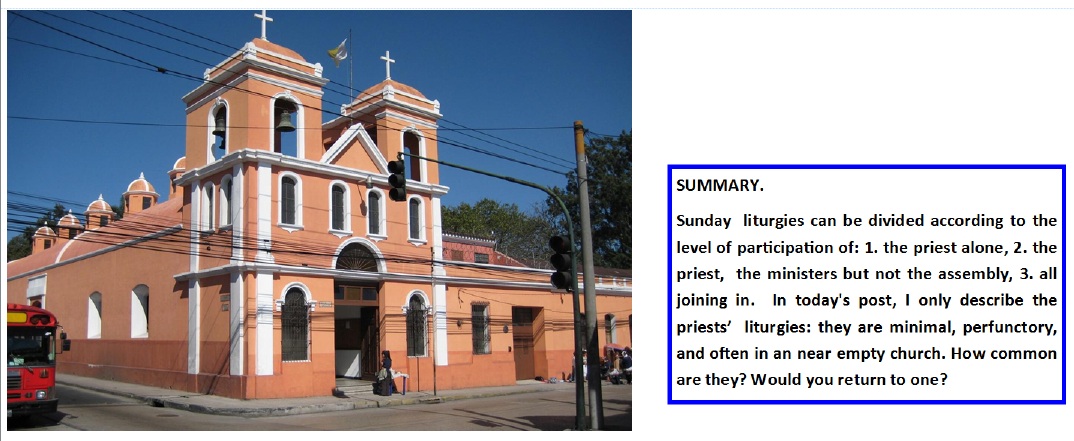
VISITING 100 CHURCHES
|
Here are the major findings of my visits to 100 churches, 50 in the US and 50 in Guatemala. 1) On Saturday and Sunday evenings, a substantial number of Masses are still like pre-Vatican II silent priestly performances, often in front a nearly empty church; their exact number was not the purpose of this study. 2) The vast majority of American Sunday celebrations range from average to good post-Vatican II liturgies, with a choir and many liturgical ministers, which often translates into a rather passive participation of the assembly. 3) It may be shocking to read that in my U. S. small sample I did not find any community or assembly celebration, while in Guatemala there is about one in three. How can this be true? - Many U.S. Sunday liturgies are good; they are just not outstanding. If I were to compare the 50 U.S. churches I visited with the few evangelical ones I know, I would come to the same conclusion: three Michelin stars for the former (because they are good) and four or five stars for the latter (because they are better than good). Many parishes are closing, and those that remain open are only supposedly only 52% full on average, while Protestant meta-churches are booming. Do you still think that our good liturgies are good enough fifty years after Vatican II? - I observed most of the churches I visited from the center or the back. If you are a good parishioner, you are likely to be in the front where most people sing and participate. The picture from the middle and back is quite different; it is not one of participation, but that's where most people sit ((about 60-70% of the faithful). - It is true that since Vatican II the liturgy has become more of a dialogue allowing the congregation to participate by singing "Lord, hear our prayer," and recite the Creed. Are you satisfied with that? Statistically in the US church attendance has declined more among Catholics than among Protestants and even more among the young Catholics. Many or most Catholics believe that Sunday church attendance is not mandatory, and even that all religions offer an equally valid path to salvation. Is it surprising then that there are three times more Catholics joining Protestant (mainly evnangelical) churches than Catholics joining the Protestants? In an anti-establishment age, the permission from above to say Amen or Alleluia at appointed times is not very attractive; people may be looking for alternatives. - I only write about the 50 U.S. churches I visited. I know that there are many dynamic parishes here; some excel in the liturgy, others in social justice, others in racial integration, and others in service to the poor, etc. But it seems to me that these excellent parishes reflect individual charisms rather than an overall vision. The research of Emerging Models of Parish Leadership found that there is “little consistency and uniformity among these emerging models.” In short, there is no global emerging model or vision.
There is nothing equivalent in the U. S. The Catholic bishops have not produced any visionary document since Economic Justice for all in 1986. Since then, the bishops have been mainly concerned with maintenance, the bickering with politicians about abortion and the internal conflicts over the closing of schools and parishes, to say nothing of their draining effort to put behind the now ten year old and continuing crisis about sexual abuse and concealment. The U.S. Catholic Church was most vibrant after the effervescence of Vatican II. It ended with the nomination of more conservative bishops. As a consequence, the U.S. Catholic Church has been desperately fragmented into conservative and liberal factions. For many, the future is now only the continuation of the present. Pretty sad. In short, the sociological significance of this research does lie in its percentages but its comparative analysis. Had I only presented Latin American findings, American readers might have found them irrelevant, as foreign or non-American – and they may do so anyway. In a comparative perspective, however, the data are as much revealing about the U.S. than about Guatemala. Will American Catholics learn from achievements abroad? Or will they remain self-satisfied by mainly looking inwards? Does your parish have a vision for the future? Does it have a pastoral plan for the next five to ten years. All businesses must have a strategy for the future; without it they can only decline.
|